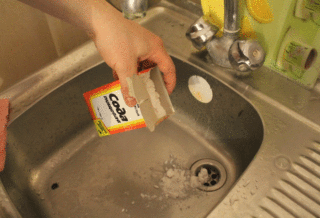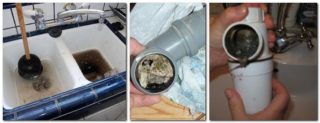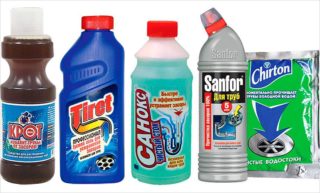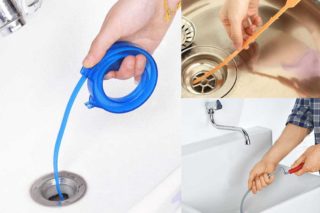A blockage in pipes most often catches us at the most unexpected moment, in the process of washing dishes or taking a bath. This greatly complicates the process of household chores, so an immediate decision is often required. You can clear the blockage in the sewer pipe yourself, you will learn from this article.
- How to understand that a blockage has appeared in the pipes
- The main causes and locations of clogging
- Household cleaning options
- Baking soda and vinegar
- Caustic soda
- Baking soda with vinegar and chlorine
- Coarse salt and vinegar
- Lemon acid
- Alka-Seltzer tablets
- Special chemicals
- Mr. Muscle
- Mole
- Pothan
- Flop
- Mechanical ways to unclog a blockage
- Ventuz
- Plumbing cable
- Dismantling the siphon
- Which cleaning method in which case to choose
- How to avoid future problems
How to understand that a blockage has appeared in the pipes
In addition, an unpleasant odor may become a clear sign of a future blockage, which indicates that dirt and grease residues have collected on the inside of the pipe.
The main causes and locations of clogging
To understand where the blockage is, you need to collect some water in the sink or bathroom, and see how it will drain:
- The water decreases very badly, and it takes a long time. Most likely, the blockage is located more than 100 centimeters from the drain;
- The water "leaves" a little, and remains in this position. The pipe clogged from the siphon to the first bend;
- The water does not go away at all. Most often, a dirty siphon is to blame for this.
- Dirt and grease adhering to the pipe from the inside. When debris begins to cling to them, this leads to a serious blockage;
- Dishwashing detergents containing surfactants. These components pose the same problem as grease and dirt;
- Limescale. It appears due to impurities in the water;
- Earth and sand. A common problem that appears in the bathroom if street shoes are washed there;
- Foreign objects accidentally dropped into the drain;
- Pipes made of cast iron become clogged due to the formation of rust bumps inside them. Most often, such a plaque appears in the pipe from the sink in the kitchen to the bath;
- Plastic pipes can become clogged due to improper installation. For example, with an incorrectly made angle of inclination, the likelihood of blockage increases several times.
You can clean the clogged pipe on your own. There are many different ways to do this.
Household cleaning options
Baking soda and vinegar

Caustic soda
You will need 2 to 3 kg to make a cleanser caustic soda (available at the hardware store), a plastic scoop, and a metal bucket.
Pour the powder into a bucket and add 10 liters of cold water. Stir the baking soda for at least half an hour until the powder is completely dissolved. Try not to get the solution on your skin. Then heat the solution on the stove to a temperature of 70 degrees. Do not let the baking soda boil or it will lose its properties.
Pour half of the mortar into the pipe and let it sit for 2 hours.After the indicated time, pour in the rest of the soda and wait another two hours. Then rinse the pipes thoroughly with hot water.
Baking soda with vinegar and chlorine
Pour 100 g into the pipe. soda, and after half an hour, pour 150 ml there. vinegar and chlorine. Close the hole tightly. After half an hour, you can wash off the remnants of substances with hot water.
Coarse salt and vinegar
Pour 300 g into the pipe. salt, add 2 liters of boiling water and 100 ml to it. 70% vinegar. Check the result in half an hour. If the blockage persists, repeat the procedure.
Lemon acid
Pour 100 g into the pipe. citric acid, and pour 250 ml of it. hot water. After 20 minutes, flush the pipe with plenty of hot water.
Alka-Seltzer tablets
This recipe replaces the use of baking soda and greatly simplifies the process. Place a desk of pills in the drain and then fill them with 250 ml. vinegar and 50 ml. water. Leave the product on for just a couple of minutes and rinse the pipe with hot water.
Special chemicals
Mr. Muscle
Mole
This is a very inexpensive domestic tool that can remove completely different blockages. Pour in 200-250 ml. into the drain and let sit for 2 hours. After the specified time has elapsed, flush the pipe with a strong pressure of water. If the blockage cannot be cleared the first time, use the product again. A mole is much cheaper than imported counterparts, no more than 70 rubles.
Pothan
Before starting to use, lower the water level in the drain by 5 cm. Then fill with 100 ml. funds and 100 ml. boiling water. After 5 minutes, rinse the drain with warm water. Suitable for all blockages in cast iron and plastic pipes.
Flop
Pour the product into the drain and add hot water. The correct proportions are indicated on the packaging. Then rinse the drain thoroughly with cold water. The product is very corrosive, so wear gloves, a respirator and a protective apron or special suit before using it.
Mechanical ways to unclog a blockage
Ventuz
- Drain the sink, leaving a little liquid at the drain;
- Lubricate the edges of the plunger with grease or petroleum jelly, this will help to attach it more tightly to the bottom of the sink;
- If there are several sinks or bathtubs in the house, fix their drain holes;
- Install the plunger directly on the drain hole, and make several active pressing movements;
- If the blockage persists, repeat the procedure. If everything succeeds, flush the drain with hot water.
Plumbing cable
Instructions for using the plumbing cable:
- Remove the siphon;
- Run one end of the cable into the pipe;
- Push the cable. Rotating it to one side at the same time;
- If the cable is stuck, pull it back without stopping to rotate;
- Try to push the cable a couple more times and pull it out;
- We clean the end of the cable. And again we run it into the pipe until it is completely cleaned.
Dismantling the siphon
- Place a small basin under the pipe that you will disassemble;
- Unscrew the locking nut that holds the siphon tube;
- Clean the dirty siphon with a brush and hot water;
- At this time, you can already pour any blockage agent into the pipe. Do everything as instructed;
- Return the siphon to its place.
Which cleaning method in which case to choose
For fresh slime and grime, choose all baking soda and Mole recipes. If the blockage is caused by stuck hair, use Flop.
For old corks, Mister Muscle, Pothan, Alco-Seltzer and caustic soda are suitable. In addition, such a blockage can be eliminated with a plunger, which will simply break it.
The lime plug is removed by citric acid.For cast iron pipes, a recipe with coarse salt is suitable. For plastic pipes, you can use Mole or Pothan.
If a foreign object needs to be removed, use a plumbing cable or disassemble the siphon.
How to avoid future problems
Most often, the cause of the blockage is fat, which settles on the walls of the pipe if you wash the dishes with cold water or low-quality detergent. To avoid unpleasant consequences, try to remove food residues from dirty dishes before washing them. Spill the pipe with hot water once a week for 30-40 minutes.













